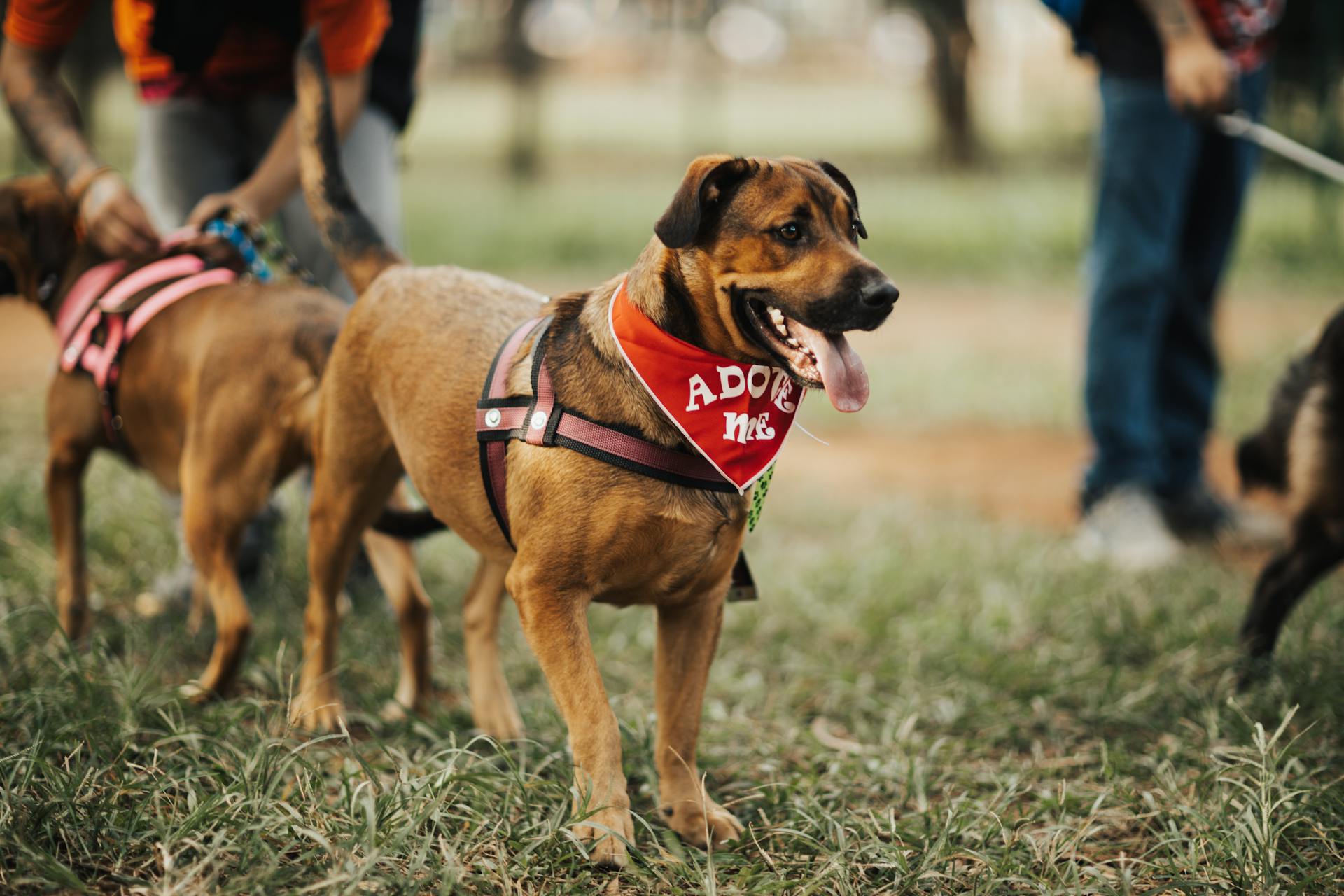
Tail chasing in dogs can be a frustrating and concerning behavior for many pet owners. It's a complex issue that can stem from various underlying causes.
Dogs often develop this behavior due to neurological disorders, such as narcolepsy, idiopathic epilepsy, or anxiety disorders.
In some cases, tail chasing can be a compulsive behavior, often triggered by boredom, stress, or anxiety. It's essential to identify the root cause to develop an effective solution.
Some breeds, like the Jack Russell Terrier, are more prone to tail chasing due to their high energy levels and strong prey drive.
Take a look at this: Dog Chasing Person
Causes of Tail Chasing
Dogs chasing their tails can be caused by boredom, which is often due to a lack of physical or mental stimulation. This is especially true if they're left alone most of the day.
Increasing daily activity by adding more regular walks and engaging their mind with games like fetch or brain puzzles can fix the problem.
Medical conditions like seizures, pain, infections, or even cancer might cause a dog to obsessively chase their tails. It's essential to rule out any underlying health issues first.
If your dog is excessively chasing their tail, it's best to consult with your vet who will be able to examine them and find the root of the problem.
Is Tail Chasing a Problem?
Tail chasing can be a sign of underlying medical issues, such as arthritis, skin allergies, or infections.
In some cases, it's also a learned behavior, often seen in dogs that are bored or lack mental stimulation.
A study found that about 5% of dogs exhibit tail chasing behavior.
When Isn’t Amusing
If your dog chases his tail more frequently, it's time to consult your veterinarian, as this could be a sign of an underlying medical or behavioral problem.
Your veterinarian can identify the root cause of the issue and address it individually, which is the fastest route to success.
Might Seek Attention
Dogs might chase their tails to seek attention. If they feel like they're not getting enough attention from you, most dogs will pull out all the stops to try and get a reaction from you.
This behavior is not just a nuisance, it's a sign that your dog is craving interaction. Our four-legged friends are sociable creatures and need plenty of attention.
In fact, dogs will see any press as good press, even if it's negative. They'll see reprimanding them as a win because they're getting a response from you.
To address this issue, it's essential to set aside time each day to spend with your dog. This will help them feel more fulfilled and less likely to engage in attention-seeking behaviors.
Take a look at this: Why Is My Cat's Tail Getting Thinner?
Why Do Dogs Chase Their Tails?
Dogs chase their tails for many reasons, and it's not always a cause for concern. Some dogs may chase their tails as a playful expression, especially in puppies.
Tail chasing can be a symptom of a compulsive disorder, much like compulsive self-licking. This implies that the dog has a genetic predisposition toward this behavior when in situations of anxiety or conflict.
A puppy may become aware of their tail and begin checking it out with their mouth, leading to short-lived spinning. This is a normal part of their development.
If your dog is chasing their tail due to boredom, it's often not boredom itself, but rather an inadequate level of physical activity that's the cause. Your dog may be engaging in tail chasing to exert energy.
Dogs may also chase their tails due to injuries, such as being slammed in a door, or superficial conditions like skin irritation or parasite bites. In these cases, the behavior is a way for the dog to ease discomfort.
Some dogs may be prone to tail chasing due to their breed or genetic predisposition. For example, flank sucking is common in Dobermans and whirling in Bull Terriers.
For another approach, see: Compulsive Dog Training
How to Stop Tail Chasing
Stopping tail chasing in dogs requires a multi-faceted approach. Ignoring the behavior is often the best course of action, as giving it attention - positive or negative - can actually make it worse.
Increasing your dog's activity levels can also help reduce tail chasing. This can be achieved through a lifestyle enrichment program that includes regular exercise, a healthy diet, and clear communication with owners.
Interactive toys like Kong stuffed with peanut butter can provide mental stimulation and distract your dog from tail chasing. Monitoring your dog's skin and general health is also crucial, as underlying medical issues can contribute to the behavior.
If your vet identifies a psychological cause, a behavioral modification program may be necessary. This involves identifying triggers and initiating alternate activities, such as playing with a ball or training, before the tail chasing begins.
Medication may also be an option, particularly if the behavior is linked to compulsive disorders. Anti-depressant or anti-anxiety medications, such as fluoxetine (Prozac) or sertraline (Zoloft), can help reduce the behavior.
A fresh viewpoint: Why Does Dog Tail Wag
To replace tail chasing with a more positive behavior, try training a replacement action, such as retrieving a toy or sitting and lifting a paw. Consistently reinforcing these new behaviors can help reduce tail chasing over time.
Here are some tips to help you get started:
- Ignore the behavior and don't reward it with attention or treats.
- Increase your dog's activity levels through exercise and mental stimulation.
- Provide interactive toys and engage your dog in play.
- Monitor your dog's health and seek veterinary advice if necessary.
- Consider medication or behavioral modification if the behavior persists.
Related Issues and Consequences
Tail chasing can lead to serious injuries, such as eye trauma, lacerations, and broken teeth.
Some dogs may also develop anxiety or stress due to the repetitive and often frustrating behavior.
In extreme cases, tail chasing can cause exhaustion, which can further exacerbate underlying medical issues.
Dogs with underlying medical conditions, such as arthritis or neurological disorders, may be more prone to tail chasing due to discomfort or pain.
As a result, it's essential to rule out any underlying medical issues before attempting to address the behavior.
For more insights, see: Cockapoo Behaviour Problems
Potential Health Issue?
If your dog starts chasing their tail, it could be a sign of a potential health issue.

Anal sacculitis, an irritated rectum, and parasites are all possible medical conditions that could cause this behavior.
Dogs may also be infested with intestinal parasites like tapeworms that migrate out the rectum, leading to tail-chasing.
A flea or tick infestation at the base of the tail can also cause discomfort, resulting in tail-chasing.
Pain, cancer, and seizure disorders are other medical issues that could be causing your dog's behavior.
Here are some possible medical issues that could be causing your dog's tail-chasing behavior:
- Anal sacculitis
- An irritated rectum
- Parasites
- Flea or tick infestation
- Pain
- Cancer
- Seizure disorder
Your veterinarian can diagnose and treat these medical issues, providing pain relief for injuries, preventing and treating intestinal parasites and fleas, and evacuating impacted anal glands.
Anxiety Consequences
Anxiety can have a profound impact on your dog's behavior, and one common consequence is tail chasing. In fact, anxiety might lead to tail chasing, a repetitive behavior that can be comforting for dogs.
Some typical causes of anxiety in dogs include small living areas, aggression from another pet, lack of opportunities to socialise, previous frightening experiences, and physical or emotional abuse in the home.

If you suspect your dog's tail chasing is a result of anxiety, it's essential to contact a behaviourist who can advise on how best to help your pup.
Dogs that have experienced the things listed above are far more likely to develop coping compulsions, such as tail chasing.
Here are some common triggers that can lead to tail chasing in anxious dogs:
- Small living areas (such as a kennel or a crate)
- Aggression from another pet
- Lack of opportunities to socialise
- Previous frightening experiences
- Physical or emotional abuse in the home
Breaking the cycle of self-trauma requires a little effort on the part of the dog and the dog owner, and behavior modification techniques can be effective in reducing tail chasing.
Prevention and Reinforcement
Reinforcing the behavior of tail-chasing can be a big problem, as it teaches the dog that this behavior will result in something they like or want, such as attention or treats.
If you catch yourself laughing or giving your dog a treat when they're chasing their tail, stop immediately, as this is exactly what's keeping the behavior going.
The attention or treats should be reserved for good behavior, not for tail-chasing. This will help your dog understand that there are better ways to get what they want.
To replace the unwanted behavior, train a new one, like retrieving a toy and sitting, or sitting and lifting a paw when they want attention.
Sources
- https://vcahospitals.com/know-your-pet/why-do-dogs-chase-their-tails
- https://www.petplace.com/article/dogs/pet-behavior-training/tail-chasing-in-dogs
- https://www.petmd.com/dog/behavior/why-do-dogs-chase-their-tails
- https://www.purina.co.uk/articles/dogs/behaviour/understanding-dogs/why-dogs-chase-tails
- https://www.vetwest.com.au/pet-library/tail-chasing-does-your-dog-chase-their-tail/
Featured Images: pexels.com


